Ragi.net
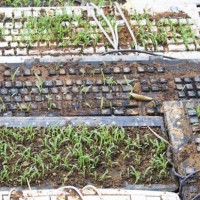
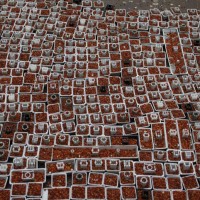
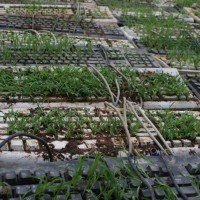
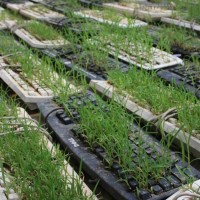
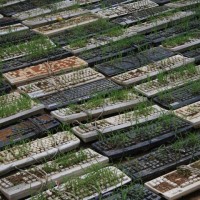

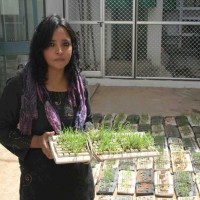
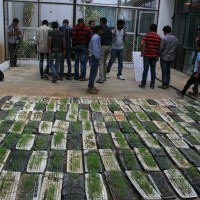
Surekha-
Ragi.net – Post Oil City- Bangalore Gardens Reloaded.
A time and space specific work
Industrial museum, Bangalore.
To the left of a life size replica of Wright brothers’ first ever airplane, a small enclosure opens to the science museum visitors with a lawn of ragi (millet) growing out of computer keyboards. Dark, chocolaty mud sits in the unfamiliar space between the keys. Tightly wound with their own cords the keyboards are black, grey and white arranged in a rectangle with bright green sprouts of millet peeping out of the gaps. This is no groomed lawn, but Surekha’s conceptual art for the exhibition Post Oil city- Bangalore Garden Reloaded. An estimated number of five thousand visitors will see the work as part of their visit to the museum every day.
Varthur, a village ensconced amidst IT firms and fast rising residential apartments near Sarjapur, thirty kilometres from Bangalore city is where these keyboards were revamped into their new avatars. After Surekha sourced the keyboards from an e-waste shop, Subramani a farmer and artist at Madappanahalli followed the process of sowing ragi on the keyboards just like his family does every year on their actual fields. The rich mud is from these fields.
Slightly bewildered museum visitors scrutinize the paradoxical coupling and walk over to a smaller installation eight feet away. Here hundreds of computer keys separated from the boards are kept upside down like toy cups; the half an inch hollows holding little servings of brown, globular grains of ragi. Their individual textual symbol is now invisible, creating instead a more democratic picture of millet wielding gathering. In unison they also appear like a topographical screen shot from Google Earth.
Traveling several times to the village, Surekha met Subramani and his family to observe the Ragi being grown for her installation. This simple act of going out of the city every few days is an interesting decision. The need to ‘get away’ from the city and make this installation probably arises out of an urban angst and by roping in Subramani, Surekha accepts her urban-inability to make any real change on her own. Instead the spotlight is on a farmer and his now techno-avaricious surroundings. Filled with the grains the keys are like strange mascots of a mixture of farming and technology that could be a utopian vision of the future.
Situated in a science museum at first glance Ragi.net’s purpose seems ambiguous other than its textual pun of farming in conjunction with technology. It becomes more lucid when it is seen as the experiment of an urban artist (Surekha and her generation has been witness to large scale transformations of villages into the city) using ideas and materials that oppose one another. Ultimately the keyboard ragi will not survive to become fully grown crops.
On the weighing scale of rationality the museum’s collection of working models severely outweighs the millet keyboards but Ragi.net is in fact drawing attention to this acquiescence of what appears to be under charted control of men as seminal.
Like an independent inventor tinkering in a garage-lab Surekha’s attempt seems to serve no direct utilitarian purpose but out of which lateral breakthroughs in praxis and thought can take place. Ragi.net is an act of defiance at the very notion of what can and cannot be done.
R Dhanya
Art Critic, Bangalore
February 2013